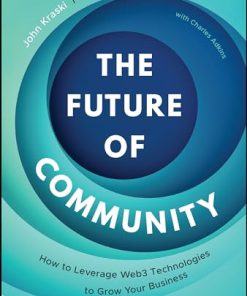How to Commercialize Chemical Technologies for a Sustainable Future 1st Edition by Timothy Clark, Andrew Pasternak ISBN 9781119604846 1119604842
$50.00 Original price was: $50.00.$25.00Current price is: $25.00.
How to Commercialize Chemical Technologies for a Sustainable Future 1st Edition by Timothy Clark, Andrew Pasternak – Ebook PDF Instant Download/Delivery: 9781119604846 ,1119604842
Full download How to Commercialize Chemical Technologies for a Sustainable Future 1st Edition after payment
Product details:
ISBN 10: 1119604842
ISBN 13: 9781119604846
Author: Timothy Clark, Andrew Pasternak
The definitive guide for scientific entrepreneurs commercializing sustainable technologies in the chemical sector Lacking the considerable resources of multinational chemical companies, entrepreneurs face a unique set of risks and challenges. How to Commercialize Chemical Technologies for a Sustainable Future is targeted at innovators who are embarking on the entrepreneurial path with their sustainable chemical technology but are unsure of what steps to take. This first-of-its-kind resource features contributions from a diverse team of expert authors, including engineers, venture capitalists, marketing specialists, intellectual property professionals, regulatory experts, industry practitioners, and many others. Accessible and highly practical, this real-world guide covers each step of the technology commercialization process, from market landscape analysis and financing to scale-up and strategic partnering. Throughout the book, effective tactics and strategies for growing a new venture are supported by case studies highlighting the economic and environmental impact of successful commercialization, and identifying the common mistakes that lead to lost opportunities. Filled with invaluable advice and actionable steps, this book: Uses valuation concepts, tools, and examples to demonstrate that for a chemical technology to be sustainable it must not only have market value but also confer benefits to human well-being and the environment Offers templates and tools for understanding what customers need, who the competition is and how to successfully differentiate your product to those customers Describes how to practically advance your technology from conception all the way to commercial demonstration Presents advantages and disadvantages of strategic partnering from the perspective of the start-up and the larger industrial partner, along with strategies to mitigate risks within a partnership Provides an overview of the legal regulatory requirements for bringing new chemicals to market in several key geographic regions, as well as the impact of public policy on commercialization Offers insights and practical strategies on intellectual property management, raising investment, and operationalizing a startup company How to Commercialize Chemical Technologies for a Sustainable Future is essential reading for budding entrepreneurs in chemistry, materials science, and chemical engineering looking to bring their sustainable technologies to market. It is also a valuable reference for investors, policymakers, regulators, and other professionals.
How to Commercialize Chemical Technologies for a Sustainable Future 1st Edition Table of contents:
1 Introduction
1.1 What Is This Book About?
1.2 What Is a Sustainable Chemical Technology?
1.3 Commercializing Sustainable Chemical Technologies Is Challenging
1.4 Who Should Read This Book?
1.5 Structure of This Book
1.6 Using This Book
Acknowledgments
References
Part I: Laying the Foundation
2 Marketing and Landscape Analysis
2.1 Introduction: Think Marketing
2.2 Creating a Marketing Plan: The Application Framework
2.3 Customer Needs and Mapping
2.4 Customer Analysis: How to Gather Customer Needs Data
2.5 Customer Needs Mapping
2.6 Market Segmentation
2.7 Market Segment Evaluation
2.8 Competitive Landscape and Competencies
2.9 Conclusion and Next Steps
3 Determining the True Value of a Sustainable Chemical Technology
3.1 Introduction
3.2 Sustainable Value and the United Nations Sustainable Development Goals
3.3 Life‐Cycle Thinking and Life‐Cycle Assessment
3.4 Attributes and Impacts: Check Your Assumptions
3.5 Business Risk and Sustainable Design – Or How to Turn an Externality into a Selling Point
3.6 Guiding Principles for Sustainable Chemical Technology Innovations: Chemistry, Carbon, and Circularity
3.7 Chemical and Material Considerations that Impact Sustainable Value
3.8 Introducing Your Sustainable Chemical Technology into the Marketplace
3.9 Conclusions
References
4 Intellectual Property Management and Strategy
4.1 Intellectual Property
4.2 What Is an Intellectual Property Right?
4.3 The Value of Intellectual Property Rights to a Sustainable Chemical Technology Company
4.4 Patents Explained
4.5 Building an IP Portfolio
4.6 Avoiding Other People’s IPRs
References
Part II: Political and Environmental Considerations
5 Navigating and Leveraging Government Entrepreneurial Ecosystems for Support
5.1 What Is an Entrepreneurial Ecosystem?
5.2 Types of Resources Available
5.3 Ecosystems in the United States and Canada
5.4 Ecosystems in the European Union
5.5 Setting Priorities When Pursuing Resources
5.6 Conclusion: Engage with Your Ecosystem
References
6 Factoring in Public Policy and Perception
6.1 Introduction
6.2 Chemicals and Policy
6.3 New Trends and Approaches
6.4 Conclusion: Policy as Strategic Advantage for the Sustainable Chemistry Innovator
Acknowledgments
References
7 Pre‐market Approval of Chemical Substances: How New Chemical Products Are Regulated
7.1 Introduction
7.2 Overview
7.3 United States
7.4 European Union (EU)
7.5 China
7.6 Canada
7.7 Developing a Global Strategy
7.8 Summary
References
Part III: Springing into Action
8 Navigating Supply Chains
8.1 Introduction
8.2 Supply Chain Complexity
8.3 Recognizing Points of View
8.4 Supply Chain Hurdles and Strategies to Overcome Them
8.5 Lessons Learned
References
9 Strategic Partnering
9.1 Introduction
9.2 Advantages and Disadvantages of Strategic Partnering
9.3 The Start‐Up Perspective: Partnership Advantages and Disadvantages
9.4 The Industrial Partner Perspective: Partnership Advantages and Disadvantages
9.5 Mitigation of the Disadvantages and Risks
9.6 Evaluating a Potential Partnership
9.7 Establishing the Partnership
9.8 Executing the Partnership
9.9 Closing the Partnership
9.10 Case Studies
References
10 Bridging the Gap 1: From Eureka Moment to Validation
10.1 Introduction
10.2 Fundamental Research Leading to an Invention
10.3 Proving the Concept
10.4 The Tech Team: Moving Beyond an Academic Group
10.5 Developing the Road Map
10.6 Defining Your Technology Development Requirements
10.7 The Innovation Cycle: Design, Simulate, Fabricate, Test, Iterate
10.8 Accelerating the Process
10.9 Growing and Evolving the Team
10.10 Summary
References
11.1 Bridging the Gap 2: From Validation to Pilot Scale‐Up
11.1.1 Introduction
11.1.2 Letting Go and Obtaining External Expertise
11.1.3 Safety Considerations
11.1.4 Commercial Considerations
11.1.5 Techno‐Economic Assessment
11.1.6 Conclusion
Notes
11.2 Bridging the Gap 2: From Validation to Pilot Scale‐Up
11.2.1 Introduction
11.2.2 Piloting and Scale‐Up Basics
11.2.3 Process and Equipment Considerations
11.2.4 Pilot Plant Operation and Location
11.2.5 Conclusion
12 Raising Investment/Financing
12.1 Introduction
12.2 Main Investment Sources
12.3 Unique Considerations for Investing in Sustainable Chemistry
12.4 Financing Considerations
12.5 Best Practices to Present Your Company to an Investor
12.6 Financing Case Study: Cnano Technology
Reference
13 Operationalizing a Start‐Up Company
13.1 Introduction
13.2 Oversight Boards
13.3 Systems
13.4 Conclusion
Part IV: Success Stories
14.1 Making an Impact: Sustainable Success Stories
14.1.1 The Vision
14.1.2 The Core of the Technologies
14.1.3 Determining the Value Proposition
14.1.4 The Commercialization Pathway
14.1.5 Financing
14.1.6 Development and Validation
14.1.7 Successes
14.1.8 Lessons Learned
References
14.2 Making an Impact: Sustainable Success Stories
14.2.1 Initial Technology and Business Model
14.2.2 Change in Direction
14.2.3 Exploring and Validating a New Opportunity
14.2.4 Huge Challenges and Huge Advances
14.2.5 Expanding Our Technology Portfolio
14.2.6 Additional Strategies and Lessons Learned
14.2.7 Summary
References
14.3 Making an Impact: Sustainable Success Stories
14.3.1 Blind Luck or Preparation?
14.3.2 Hazel Technologies: How It Started and Where We Are Today
14.3.3 Understanding What Our Business Really Is
14.3.4 Targeting Value Through the Supply Chain
14.3.5 Final Thoughts
Index
People also search for How to Commercialize Chemical Technologies for a Sustainable Future 1st Edition:
how to transform the chemical industry
how is technology used in chemical engineering
how is chemistry used in technology
chemical recovery process in paper industry
how to improve chemical energy
Tags: Timothy Clark, Andrew Pasternak, Commercialize Chemical Technologies, Sustainable Future
You may also like…
Uncategorized
Chemistry for Sustainable Technologies 2nd Edition by Neil Winterton 1788019334 9781788019330
Science (General) - Research & Development
Addicted to Growth Societal Therapy for a Sustainable Wellbeing Future 1st Edition Robert Costanza
Engineering - Energy & Power Resources
Petroleum Nanobiotechnology: Modern Applications for a Sustainable Future 1st Edition El-Gendy
Technique - Automation
Computers - Computer Business & Culture
Engineering - Energy & Power Resources
Chemistry - Technical & Industrial Chemistry
Engineering - Social & Cultural Aspects of Technology
Computers - Artificial Intelligence (AI)
IoT and AI Technologies for Sustainable Living: A Practical Handbook 1st Edition Abid Hussain












